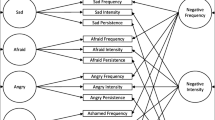Abstract
As part of a telephone survey, respondents were asked to report the most recent situation that evoked strong emotional feelings in them and to describe the pattern of their reactions. The majority of the situations reported had evoked negative emotions. Most of the emotion-antecedent events are connected to relationships with family and friends or to work-related situations. Only happiness and anger are reported as relatively pure feeling states; most others are emotion blends, with anger/sadness and sadness/fear occurring most frequently. Facial expression changes as well as heart and muscle symptoms are reported as the most frequent reactions across all emotions, whereas other nonverbal and physiological reactions are more specific for particular emotions. By the use of factor analysis, response patterns across various components of emotional state, including affect control, are explored.
Similar content being viewed by others
References
Averill, J. R. (1980). A constructivist view of emotion. In R. Plutchik & H. Kellermann (Eds.),Emotion. Theory, research and experience (Vol. 1, pp. 305–340). New York: Academic Press.
Averill, J. R. (1982). Anger and aggression: An essay on emotion. New York: Springer.
Ekman, P. (1984). Expression and the nature of emotion. In K. R. Scherer & P. Ekman (Eds.),Approaches to emotion (pp. 319–344). Hillsdale, New Jersey: Erlbaum.
Ekman, P., Levenson, R. W., & Friesen, W. V. (1983). Autonomic nervous system activity distinguishes among emotions.Science, 221 1208–1210.
Frijda, N. H. (1986).The emotions. Cambridge: Cambridge University Press.
Izard, C. E. (1977).Human emotions. New York: Plenum.
Nisbett, R., & Ross, L. (1980).Human inference: Strategies and shortcomings of social judgment. Englewood Cliffs, New Jersey: Prentice-Hall.
Pennebaker, J. W. (1982).The psychology of physiological symptoms. New Yorker: Springer.
Rapaport, D. (1950).Emotions and memory. New York: International University Press.
Roseman, I. J. (1984). Cognitive determinants of emotion: A structural theory. In P. Shaver (Ed.),Review of personality and social psychology (Vol. 5, pp. 11–36). Beverly Hills, London: Sage.
Scherer, K. R. (1984). On the nature and function of emotion: A component process approach. In K. R. Scherer & P. Ekman (Eds.),Approaches to emotion (pp. 239–317). Hillsdale, New Jersey: Erlbaum.
Scherer, K. R. (1986). Emotion experience across European cultures: A summary statement. In K. R. Scherer, H. G. Wallbott, & A. B. Summerfield (Eds.),Experiencing emotion: A cross-cultural study (pp. 173–189) Cambridge, Cambridge University Press.
Scherer, K. R., Summerfield, A. B., & Wallbott, H. G. (1983). Cross-national research on antecedents and components of emotion: A progress report.Social Science Information, 22 355–383.
Scherer, K. R., Wallbott, H. G., & Summerfield, A. B. (Eds.). (1986).Experiencing emotion: A cross-cultural study. Cambridge: Cambridge University Press.
Shanks, M. (1983). The current status of computer-assisted telephone interviewing: Recent progress and future prospects.Sociological Methods and Research, 12 119–141.
Smith, C. A., & Ellsworth, P. C. (1985). Patterns of cognitive apparisal in emotion.Journal of Personality and Social Psychology, 48 813–838.
Tomkins, S. S. (1962).Affect, imagery, consciousness. Vol. 1. The positive affects. New York: Springer.
Tversky, A., & Kahneman, D. (1974). Judgment under uncertainty: Heuristics and biases.Science, 185 1124–1131.
Author information
Authors and Affiliations
Additional information
The first author gratefully acknowledges support from the Stiftung Volkswagenwerk for a sabbatical leave to the University of California at Berkeley.
Rights and permissions
About this article
Cite this article
Scherer, K.R., Tannenbaum, P.H. Emotional experiences in everyday life: A survey approach. Motiv Emot 10, 295–314 (1986). https://doi.org/10.1007/BF00992106
Issue Date:
DOI: https://doi.org/10.1007/BF00992106




